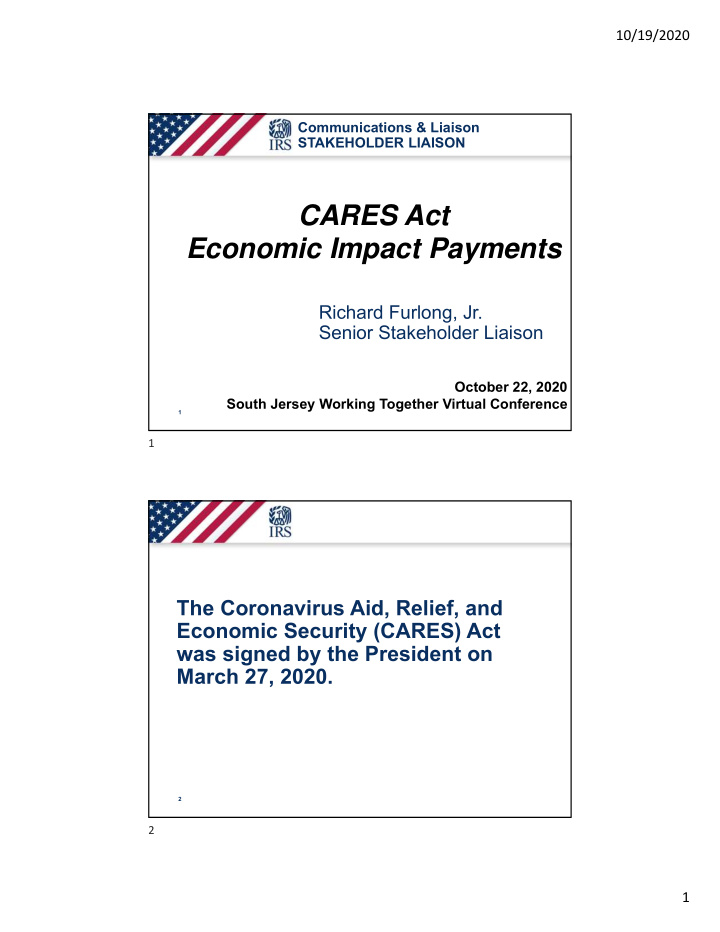



10/19/2020 Communications & Liaison STAKEHOLDER LIAISON CARES Act Economic Impact Payments Richard Furlong, Jr. Senior Stakeholder Liaison October 22, 2020 South Jersey Working Together Virtual Conference 1 1 The Coronavirus Aid, Relief, and Economic Security (CARES) Act was signed by the President on March 27, 2020. 2 2 1
10/19/2020 Economic Impact Payments Economic Impact Payments (EIP) have also been referred to as: • “Stimulus Payments” They are advance refunds of the “Recovery Rebates” provided in the legislation. 3 3 Amount of Payment Payments are up to the following amounts: • $2,400 for two eligible individuals filing joint returns • $1,200 for each eligible individual • $500 for each qualifying child claimed by an eligible individual 4 4 2
10/19/2020 Qualifying Child More information regarding: • Payment up to $500 for each qualifying child • IRS.gov: Economic Impact Payments: Qualifying Child Requirements 5 5 Payment amounts Economic Impact Payment (EIP) amount in full if: Filing Status AGI Not More Than Married Filing Joint $150,000 Head of Household $112,500 All Other $75,000 6 6 3
10/19/2020 Limitation Based on AGI Taxpayers (with no qualifying children) will receive a reduced payment if their AGI is between: Filing Status AGI Greater Than AGI Less Than Married Filing Joint $150,000 $198,000 Head of Household $112,500 $136,500 All Other $75,000 $99,000 7 7 Who is not eligible? Not eligible: • Dependents who can be claimed on someone else’s tax return • Non-resident aliens 8 8 4
10/19/2020 Notification • IRS mails Notice 1444, Your Economic Impact Payment, within 15 days after payment goes out • Keep Notice 1444 with tax records • Notice provides information about the amount of the payment, how it was made and how to report any payment that wasn’t received. 9 9 Get My Payment 10 10 5
10/19/2020 Get My Payment FAQs 11 11 Non-Filer Tool 12 12 6
10/19/2020 Non-Filer Tool FAQs 13 13 Payment Delivery People who aren't typically required to file a tax return: • Social Security and Railroad Retirement recipients • SSDI, SSI and certain veterans • Other individuals such as low-income workers, certain veterans and individuals with disabilities 14 14 7
10/19/2020 September 30 th deadline People who aren't typically required to file a tax return: • Social Security and Railroad Retirement recipients • SSDI, SSI and certain veterans IR-2020-180, August 14, 2020: IRS takes new steps to ensure people with children receive $500 Economic Impact Payments 15 15 Special Letter IR-2020-203, September 8, 2020: IRS to mail special letter to estimated 9 million non-filers, urging them to claim Economic Impact Payment by Oct. 15 at IRS.gov 16 16 8
10/19/2020 November 21 deadline • November 21 deadline for people who aren't typically required to file a tax return. • For example, people with little or no income who don’t receive federal benefits such as SSDI or SSI. • IR-2020-229, October 5, 2020. IRS extends EIP deadline to Nov. 21 to help non-filers • Note: This additional time into November is for those who have not received their EIP and don't normally file a tax return. • Taxpayers who requested an extension of time to file their 2019 tax return deadline remains October 15. • People using paper method to claim EIP need to submit by October 15. 17 17 Who should not use the Non-Filer tool • Do NOT use this tool if you will be filing a 2019 return. • This includes those who file a tax return to get a refund even though they are not required to file a tax return. • Using the tool instead of filing your 2019 return will slow down processing of your tax return and receiving any tax refund. 18 18 9
10/19/2020 Need to file a return instead? • People should check to see if they should file a return by October 15 to claim tax credits and their Economic Impact Payment instead of using the Non-Filers tool. • Many low-income individuals qualify for tax credits, even if they owe no tax or aren’t required to file tax returns • Explore the IRS Interactive Tax Assistant and EITC Assistant on IRS.gov to see if they qualify for other tax credits. 19 19 Who should use the Non- Filer tool Use the Non-Filer tool if you do not normally file a return and are not planning to file a federal income tax return for 2019 because: • Your income is less than $12,200 • You’re married filing jointly and together your income is less than $24,400 • You have no income 20 20 10
10/19/2020 Non-Filers: Enter Payment Info 21 21 Three ways to get EIP IRS now has three ways non-filers can sign up for an Economic Impact Payment: 1. Non-Filers: Enter Payment Info Here tool at IRS.gov – Deadline is November 21 2. Mail the online form: Use the Non-Filers tool to complete the form online, then stop before e-filing, print the information and mail it to the IRS. – Deadline is October 15 3. Mail a Form 1040 or a Form 1040-SR (for seniors) to file a “simplified return” to claim an EIP. – Deadline is October 15 22 22 11
10/19/2020 Watch out for scams Watch out for scams related to Economic Impact Payments • Watch for scams related to Economic Impact Payments • Some use email, phone calls or texts • IRS will not send unsolicited electronic communications asking people to open attachments, visit a website or share personal or financial information • IRS.gov has official information • Non-Filers tool and Get My Payment tool are only available on IRS.gov 23 23 IRS.gov homepage 24 24 12
10/19/2020 EIP Information Center 25 25 Partner and Promotional Materials 26 26 13
10/19/2020 Communications & Liaison STAKEHOLDER LIAISON www.irs.gov/coronavirus 27 27 Connect With the IRS IRS2Go mobile app YouTube: IRS videos Twitter: @IRStaxsecurity Facebook: @IRS Instagram: @IRSnews e-News subscriptions www.irs.gov/socialmedia 28 14
10/19/2020 Communications & Liaison STAKEHOLDER LIAISON Richard Furlong, Jr. Senior Stakeholder Liaison 267-941-6343 richard.g.furlong@irs.gov 29 29 15
Recommend
More recommend